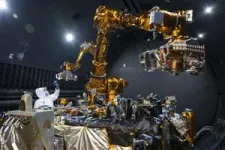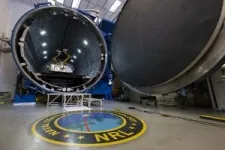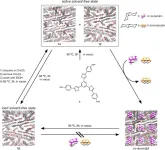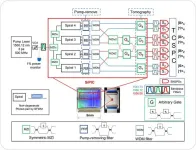(Press-News.org) WASHINGTON – U.S. Naval Research Laboratory (NRL) Naval Center for Space Technology (NCST) in partnership with Defense Advanced Research Projects Agency (DARPA) successfully completed development of a spaceflight qualified robotics suite capable of servicing satellites in orbit, Oct. 8.
Under DARPA funding, NRL developed the Robotic Servicing of Geosynchronous Satellites (RSGS) Integrated Robotic Payload (IRP). This transformative new space capability was delivered to DARPA’s commercial partner, Northrop Grumman’s SpaceLogistics, for integration with its spacecraft bus, the Mission Robotics Vehicle (MRV).
“The recent completion of thermal vacuum testing marks a major milestone toward achieving the program’s goal of demonstrating robotic servicing capabilities on orbit in the near future,” said NRL Director of Research Dr. Bruce Danly. “NRL’s contributions to the robotic payload are an essential part of realizing this vision, which promises to transform satellite operations in geostationary orbit, reduce costs for satellite operators, and enable capabilities well beyond what we have today. In fact, the anticipated capabilities are potentially revolutionary for both national security and civil applications.”
As DARPA’s robotic payload developer for the RSGS program, NRL looked to the future to design, build, integrate, and test groundbreaking satellite servicing capabilities.
“This collaboration unlocks new servicing opportunities for both commercial and government satellites, enabling usual-close inspections, orbital adjustments, hardware upgrades, and repairs,” said Bernie Kelm, NRL NCST superintendent of the Spacecraft Engineering Division. “We’ve created advanced spaceflight hardware and software that will significantly enhance satellite servicing operations, including all robotic controls.”
Satellites in geosynchronous orbit, positioned approximately 22,000 miles above Earth, are crucial for military, government, and commercial communications, Earth-observing science, and national security services.
Currently, spacecraft face significant challenges, in part because of the inability to perform in-orbit repairs or upgrades. To compensate for the lack of servicing options, satellites are often loaded with backup systems and excess fuel, leading to increased complexity, weight, and cost. Should this project prove successful, satellites can receive in-orbit upgrades based on new technology to extend their service life, Kelm added.
“The military regularly fixes aircraft, tanks, ships, and trucks that break. We upgrade aircraft and ships with the latest radars, computers, and engines,” said Glen Henshaw, Ph.D., NRL senior scientist for Robotics and Autonomous Systems. “Satellites are the only expensive equipment we buy that can’t be repaired or upgraded once they are in the field, and this costs the taxpayer money. RSGS is intended to change this situation; we intend to demonstrate that we can upgrade and repair these valuable assets using robots.”
Thermal Vacuum (TVAC) Testing Process
The test campaign put the robotic payload through its paces across the range of temperatures it will face while on-orbit and under vacuum conditions similar to space. Engineers tested all aspects of the payload including avionics, cameras, and lights, and demonstrated all operations, with each of its two robotic arms including launch lock deployments, calibrations, and tool changing. The test also verified SpaceWire communications and robotic compliance and visual servo control modes.
“NRL’s Team RSGS has spent nearly 10 years focused on the goal of completing this first of a kind, robotic servicing payload,” said William Vincent, NRL RSGS program manager. “The completion of IRP TVAC represents a huge milestone and countless hours of work from an incredible group of dedicated personnel. Like sending a child off to college for the first time, shipping the IRP to Dulles is a bittersweet experience.”
NRL worked for over two decades to mature the technology enabling the RSGS program. RSGS is designed to safely and reliably repair and upgrade valuable commercial, civil, and national security satellites, some of which cost over a billion dollars. In the near future, robotic satellite “mechanics” may extend the useful life of satellites by upgrading a variety of capabilities including new electronics, propulsion, and sensors capabilities. RSGS robots could demonstrate broad servicing as a precursor to building large structures in-orbit which could include the next great observatory, solar power stations, or other revolutionary new systems.
“We hope that this will eventually lead to spacecraft that are more modular and easier to maintain,” Henshaw said.
Following its anticipated 2026 launch on the Northrop Grumman’s MRV spacecraft bus, the robotic payload will undergo initial checkout and calibration with full operational servicing missions to follow.
“We will proudly watch RSGS as it provides resilience for the current U.S. space infrastructure and takes the first concrete steps toward a transformed space architecture with revolutionary capabilities,” Vincent said.
About the U.S. Naval Research Laboratory
NRL has a longstanding relationship with academia and industry as a collaborator, contractor, and through technology transfer partnership mechanisms, such as commercial licensing, Cooperative Research and Development Agreements, and Educational Partnership Agreements.
NRL is a critical link within the Navy’s Research, Development, and Acquisition chain and Naval Research Enterprise. Through NRL, the Navy has direct ties with sources of fundamental ideas in industry and the academic community throughout the world and provides an effective coupling point to the research and development chain for Office of Naval Research. NRL is a scientific and engineering command dedicated to research that drives innovative advances for the U.S. Navy and Marine Corps from the seafloor to space and in the information domain. NRL is located in Washington, D.C. with major field sites in Stennis Space Center, Mississippi; Key West, Florida; Monterey, California, and employs approximately 3,000 civilian scientists, engineers and support personnel.
For more information, contact NRL Corporate Communications at (202) 480-3746 or nrlpao@us.navy.mil.
END
NRL completes development of robotics capable of servicing satellites, enabling resilience for the U.S. space infrastructure
2024-11-14
ELSE PRESS RELEASES FROM THIS DATE:
Clinical trial shows positive results for potential treatment to combat a challenging rare disease
2024-11-14
An international, phase 3 clinical trial led by investigators at Mass General Brigham could improve the treatment of a rare disease that can cause debilitating symptoms. The study, published in the New England Journal of Medicine, found that treatment with inebilizumab greatly reduced the symptoms of immunoglobulin G4–related disease (IgG4-RD), compared to placebo.
“This is a huge day in the history of this disease,” said lead author John Stone, MD, MPH, a rheumatologist in the Division of Rheumatology, Allergy, and Immunology at Massachusetts General Hospital, a founding member of the Mass General Brigham healthcare system. “We are thrilled to have ...
New research shows relationship between heart shape and risk of cardiovascular disease
2024-11-14
A new multi-national study has revealed that the shape of the heart is influenced in part by genetics and may help predict the risk of cardiovascular diseases.
Researchers from Queen Mary University of London, King’s College London, University of Zaragoza and University College London, as well as Complexo Hospitalario Universitario A Coruña are first to examine the genetic basis of the heart’s left and right ventricles using advanced 3D imaging and machine learning.
Prior ...
Increase in crisis coverage, but not the number of crisis news events
2024-11-14
The world appears to be plagued by crises.
“The financial crisis, the European debt crisis, the migration crisis, the COVID-19 pandemic, the war in Ukraine, the war in Gaza… The world seems to be stumbling from one existential crisis to the next, barely recovering from one before the next one hits,” said Stefan Geiß, a professor from the Department of Sociology and Political Science at the Norwegian University of Science and Technology (NTNU).
However, are there really more crises now than before?
Has it always been this way, or is something new happening? And if there are more public crises today ...
New study provides first evidence of African children with severe malaria experiencing partial resistance to world’s most powerful malaria drug
2024-11-14
NEW ORLEANS (November 14, 2024) — A new study from Uganda provides the first evidence to date that resistance to a lifesaving malaria drug may be emerging in the group of patients that accounts for most of the world’s malaria deaths: young African children suffering from serious infections. The study, presented today at the Annual Meeting of the American Society of Tropical Medicine and Hygiene and published in the Journal of the American Medical Association (JAMA), documented partial resistance to the malaria drug artemisinin in 11 of 100 children, ages 6 months to 12 years, who were being treated for ...
Texting abbreviations makes senders seem insincere, study finds
2024-11-14
If you want to seem sincere and receive more responses to your texts, spell out words instead of abbreviating them, according to new research published by the American Psychological Association.
Researchers conducted eight experiments with a total of more than 5,300 participants using various methods. Across the experiments, individuals who used texting abbreviations were perceived as more insincere and were less likely to receive replies because they were seen as exerting less effort in text conversations. The research was published online in the Journal of Experimental Psychology: General.
“In daily interactions, ...
Living microbes discovered in Earth’s driest desert
2024-11-14
Highlights:
The Atacama Desert is one of the most extreme habitats on Earth.
Atacama surface soil samples include a mix of DNA from inside and outside living cells.
A new technique allows researchers to separate external and internal DNA to identify microbes colonizing this hostile environment.
This approach for analyzing microbial communities could potentially be applied to other hostile environments, like those on other planets.
Washington, D.C.—The Atacama Desert, which runs along the Pacific Coast in Chile, is the driest place on the planet and, largely because of that aridity, hostile to most living things. ...
Artemisinin partial resistance in Ugandan children with complicated malaria
2024-11-14
About The Study: This study found artemisinin partial resistance in Ugandan children with complicated malaria associated with the Pfkelch13 A675V variation and also found suboptimal 28-day efficacy of parenteral artesunate followed by oral artemether/lumefantrine therapy.
Corresponding Author: To contact the corresponding author, Chandy C. John, MD, MS, email chjohn@iu.edu.
To access the embargoed study: Visit our For The Media website at this link https://media.jamanetwork.com/
(doi:10.1001/jama.2024.22343)
Editor’s Note: Please see the ...
When is a hole not a hole? Researchers investigate the mystery of 'latent pores'
2024-11-14
Sometimes the holes, or pores, in the molecular structure of a chemical only appear in the presence of certain conditions or other ‘guest’ molecules. This affects the field of separation—one of the most important processes in industry—but researchers have only just begun to unravel this phenomenon
Researchers have explored how a particular chemical can selectively trap certain molecules in the cavities of its structure—even though in normal conditions it has no such cavities. This innovative material with now-you-see-them-now-you-don’t holes could lead to more efficient methods for separating ...
ETRI, demonstration of 8-photon qubit chip for quantum computation
2024-11-14
A group of South Korean researchers has successfully developed an integrated quantum circuit chip using photons (light particles). This achievement is expected to enhance the global competitiveness of the team in quantum computation research.
Electronics and Telecommunications Research Institute (ETRI) announced that they have developed a system capable of controlling eight photons using a photonic integrated-circuit chip. With this system, they can explore various quantum phenomena, such as multipartite entanglement resulting from the interaction of the photons.
ETRI’s extensive research on silicon-photonic quantum ...
Remote telemedicine tool found highly accurate in diagnosing melanoma
2024-11-14
Collecting images of suspicious-looking skin growths and sending them off-site for specialists to analyze is as accurate in identifying skin cancers as having a dermatologist examine them in person, a new study shows.
According to the study authors, the findings add to evidence that such technology could help to reliably address diagnostic and treatment disparities for lower-income populations with limited access to dermatologists. It may also help dermatologists quickly catch cases of melanoma, a serious form of skin cancer that kills more than 8,000 Americans a year.
Their new system, which the researchers call SpotCheck, enables skin cancer specialists ...




